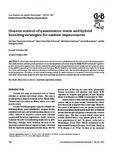Please use this identifier to cite or link to this item:
http://www.alice.cnptia.embrapa.br/alice/handle/doc/313447| Title: | Genetic control of quantitative traits and hybrid breeding strategies for cashew improvement. |
| Authors: | CAVALCANTI, J. J. V.  RESENDE, M. D. V. de   CRISÓSTOMO, J. R.   PAIVA, J. R. de   |
| Affiliation: | José Jaime Vasconcelos Cavalcanti, Embrapa Agroindústria Tropical; Marcos Deon Vilela de Resende, Embrapa Florestas; João Ribeiro Crisóstomo, Embrapa Agroindústria Tropical; Levi de Moura Barros, Embrapa Agroindústria Tropical; João Rodrigues de Paiva, E. |
| Date Issued: | 2007 |
| Citation: | Crop Breeding and Applied Biotechnology, Viçosa, MG, v. 7, p. 186-195, 2007. |
| Description: | Knowledge about genetic parameters and trait control is fundamental for the success of any breeding program. This study aimed to estimate genetic parameters in an interpopulation of cashew using the REML/BLUP methods for vegetative growth, yield and nut quality traits. Results showed that plant height, canopy diameter, kernel weight and nut weight are under strong additive genetic control and do not present heterosis. The heritability of nut number and yield were higher in the broad than in the narrow sense. This indicates dominance and heterosis of these traits that should be adequately exploited in cashew breeding programs. Therefore, the best-suited breeding strategy to exploit heterosis is reciprocal recurrent selection using individual crosses between parents with high mean genotypic performance and high specific combining ability. |
| Thesagro: | Anacardium Occidentale Caju |
| Keywords: | Programa de melhoramento |
| Type of Material: | Artigo de periódico |
| Access: | openAccess |
| Appears in Collections: | Artigo em periódico indexado (CNPF)  |
Files in This Item:
| File | Description | Size | Format | |
|---|---|---|---|---|
| geneticcontrolofquantitativetraitsandhybrid.pdf | 571.57 kB | Adobe PDF |  View/Open |









